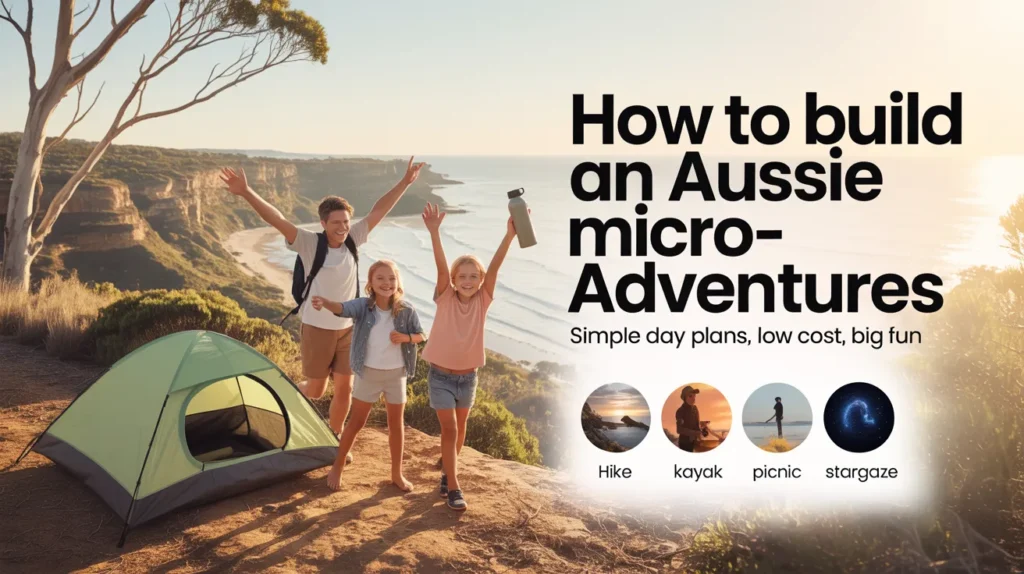
Short, local, cheap and wildly satisfying — that’s the micro-adventure. The idea (popularised by Alastair Humphreys) is to squeeze real adventure into small pockets of time: an overnight under the stars, a moonlit beach hike, or a sunrise summit before breakfast. Micro-adventures are perfect for busy Aussies who want fresh air, novelty and a break from screens without long travel or big budgets.
Below is a friendly, step-by-step guide to plan your next Aussie micro-adventure, example itineraries tailored to different cities and groups, a practical checklist, budget tips and safety reminders.
What makes a micro-adventure (quick checklist)
A true micro-adventure is:
- Close to home (a short drive, train or ferry),
- Short (even an evening or overnight counts),
- Cheap (little or no specialised gear required), and
- Simple but rewarding — something different from your usual routine.
Step-by-Step: plan your Aussie micro-adventure (the 6-step formula)
- Choose your “small but different” goal. Keep it specific: “sleep on the beach,” “reach a sunrise lookout,” or “paddle the river at dawn.” Micro-adventures thrive on a single, clear objective.
- Pick a nearby location. Use local parks, coastal reserves, national park day areas, or quiet state forest camps. The idea is minimal transit time so you can actually relax. Australian blogs and explorers list thousands of short ideas you can adapt.
- Time it tightly. One evening + one morning often works: drive late afternoon, set up, enjoy sunset, sleep, then do your mini-objective at dawn. For families, shift everything earlier (nap-friendly schedules make a big difference).
- Pack light and smart. A sleeping bag/blanket, headlamps, snacks, water, weather layers, and a basic first-aid kit are usually enough. If you’re near water, bring swimmers and towels; if you’re aiming for a summit, comfy boots. (Checklist below.)
- Check rules & safety. Confirm park opening hours, camping permits, fire bans and tide times for beaches. Short adventures are easy — until a closed gate or an unexpected tide ruins them. Australian guides strongly advise checking local conditions before you go.
- Keep it flexible & fun. The best micro-adventures are low-pressure. If the weather changes, pivot to a sunset picnic or a night-walk instead.
Quick Aussie micro-adventure ideas (city-based starters)
- Sydney: Train → short bushwalk → picnic → catch the sunset at a harbour lookout, overnight in a nearby campground or backyard sleepover. (Train-hike-train options are classic local micro-adventures.)
- Melbourne: Sunset paddle on the Yarra or a moonlight bike ride along the bay, then a hot-chocolate and a backyard camp.
- Brisbane/Gold Coast: Day paddle on the river then beach sleep-out (where permitted) or a camp at a nearby national park.
- Perth: Dusk visit to a wildflower reserve or a beach bivvy for starry skies.
- Adelaide: Explore a nearby conservation park, picnic and spot nocturnal wildlife (possums, birds).
- Hobart/Tasmania: Short drive to a dark-sky spot for stargazing — Tasmania gives great aurora chances in season.
If you want a list targeted to your city/region, I can generate 10 ready-to-use micro-adventures near you.
Family & beginner friendly options
- Backyard campout with torches, storytelling and a “micro-hike” in a local reserve the next morning.
- Beach twilight walk + marshmallow toast (where fires are allowed) or dinner picnic and early bedtime for kids.
- Day paddle + picnic on a calm waterway with a short “beach sleep” in a car (for families who prefer roof-top or car camping).
Advice from families who micro-adventure with kids: keep durations short, plan for naps, and include a guaranteed comfort item (favourite snack or toy).
Budgeting: micro-adventures are cheap (how cheap?)
- No-cost: backyard sleepout, night walk in local reserve, stargazing from a dark lookout.
- Low-cost: train + picnic, paid nearby campsite ($10–$30), cheap hire of kayaks/paddleboards (~$20–$50/hr).
- One-off splurge: organised guided kayak or snorkel trip, which you can treat as a special micro-adventure.
Keep gear minimal and reuse items you already own to keep the cost down.
Micro-adventure packing checklist (compact)
- Daypack or small duffel
- Water (1–2L pp), snacks, lightweight picnic blanket
- Headlamp or torch (red-filter option if stargazing)
- Warm layers, rain shell, hat
- Sleeping bag or warm blanket (for overnight) + inflatable mat or picnic rug
- Basic first aid, sunscreen, insect repellent
- Phone, power bank, map or offline map app
- Any permits/tickets printed or on your phone
Safety & legal notes (must-reads)
- Check national/state park sites for camping rules and permits — many coastal and island sites require bookings or vehicle permits. Don’t camp where it’s prohibited.
- For beach micro-adventures, check tide times and avoid cliff edges at night.
- Leave no trace: pack out all rubbish and follow local fire regulations. Micro-adventures are tiny footprints, not tiny excuses.
- If heading remote, tell someone your plan and expected return time.
